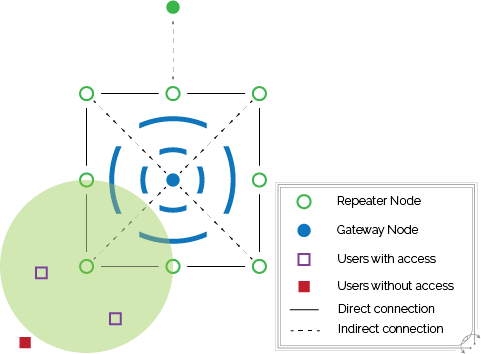Mesh networking leads to greater flexibility

Nodes in a mesh network communicate with each other to gain access to the internet. Unlike a regular network, in which every node has direct access, mesh networks are more flexible and harder to cripple.
Recently, a new technology, known as mesh networking, has arisen, allowing users to route traffic and share internet connections throughout a neighborhood. Mesh networks have recently been helpful with promoting human rights, and can also help in natural disasters.
Traditional Wi-Fi networks operate by allowing different transmitters to tap into a single wired internet connection and broadcast independent signals to users. On the other hand, a mesh network allows transmitters to connect to each other to access the Internet in a “mesh” configuration.
Austin Energy, a publicly owned Texas Utility Provider, has integrated a mesh network into the area’s power grid. Power meters in the “Smart Grid” can communicate information wirelessly through the network for more efficient monitoring and energy usage.
Mesh networks have also been suggested as solutions in disaster areas. When traditional Internet and telecommunications lines have been crippled, mesh networks could be used as a means of communication until infrastructure is rebuilt. Mesh networks have already been implemented in large hotels to provide Wi-Fi at lower costs than regular networks, which involve more wired infrastructure.
On a smaller scale, mesh networks could also be used for “smart homes”, allowing household devices to talk to each other and interact wirelessly, using consumer products created by companies like OpenMesh, Commotion Wireless, and Project Meshnet.
In a mesh network, data is relayed to a source indirectly through a chain of routers/transmitters, only a few of which are directly connected to the Internet. This makes networks more flexible and harder to cripple than a traditional network, as several nodes must be removed to hinder the flow of information in the network.
The central router, also known as a gateway, is connected to the Internet using DSL, cable, or fiber-optics. This provides a Wi-Fi connection on the standard 802.11b channel to the rest of the local mesh network.
To make the system more efficient and versatile, instead of using one central gateway, mesh networks often use several slightly slower gateways throughout the network.
To provide several access points, the mesh network also includes repeaters, standard router hubs that are not connected to the Internet. Each repeater covers a spherical area with a radius between 50 to 100 feet indoors.
As long as each repeater has a line-of-sight with the gateway, or another connected repeater, it will be able to transmit and repeat signals from local computers and other nodes on the mesh network to the gateway.
People can connect to the mesh network using standard devices, such as desktop computers, laptop computers, mobile phones, or tablets.
To create a mesh network, first place a gateway router connected to the Internet in an area that is central to the network. Alternatively, place several slower gateway routers throughout the area that will be covered.
Afterwards, place repeater networks that are not connected to the network throughout the covered area, with 1 of these per 3-6 apartments, or 1-2 per house. The larger the building, the more routers should be bought.
Several advantages to mesh networks include that they are affordable, easy to install, manage, and upgrade for people with varying levels of tech training, and are censorship resistant.
Additionally, they provide multiple access points to the network on the same Wi-Fi standard, are smaller, cheaper, and more power efficient. Oftentimes, they can fix themselves in the case of a security attack, or if a repeater fails.
However, upon gaining access to a mesh network, security is drastically decreased. The system allows attacks from neighbors and other people on the network, allowing sensitive data such as passwords to be stolen. Brute force security attacks can also compromise the system, and depending on installation, the system can be unreliable.
Although there are currently several security issues that must be approached before mesh networks become more available to the public, the new technology has the potential to become widely used throughout neighborhoods, countries, and companies over the world.
This piece was originally published in the pages of the Winged Post on May 16, 2014.

Vineet Kosaraju (12) is the STEM Editor for both Harker Aquila and Winged Post. He is a senior and has been part of the journalism program for the past...


















![“[Building nerf blasters] became this outlet of creativity for me that hasn't been matched by anything else. The process [of] making a build complete to your desire is such a painstakingly difficult process, but I've had to learn from [the skills needed from] soldering to proper painting. There's so many different options for everything, if you think about it, it exists. The best part is [that] if it doesn't exist, you can build it yourself," Ishaan Parate said.](https://harkeraquila.com/wp-content/uploads/2022/08/DSC_8149-900x604.jpg)




![“When I came into high school, I was ready to be a follower. But DECA was a game changer for me. It helped me overcome my fear of public speaking, and it's played such a major role in who I've become today. To be able to successfully lead a chapter of 150 students, an officer team and be one of the upperclassmen I once really admired is something I'm [really] proud of,” Anvitha Tummala ('21) said.](https://harkeraquila.com/wp-content/uploads/2021/07/Screen-Shot-2021-07-25-at-9.50.05-AM-900x594.png)







![“I think getting up in the morning and having a sense of purpose [is exciting]. I think without a certain amount of drive, life is kind of obsolete and mundane, and I think having that every single day is what makes each day unique and kind of makes life exciting,” Neymika Jain (12) said.](https://harkeraquila.com/wp-content/uploads/2017/06/Screen-Shot-2017-06-03-at-4.54.16-PM.png)








![“My slogan is ‘slow feet, don’t eat, and I’m hungry.’ You need to run fast to get where you are–you aren't going to get those championships if you aren't fast,” Angel Cervantes (12) said. “I want to do well in school on my tests and in track and win championships for my team. I live by that, [and] I can do that anywhere: in the classroom or on the field.”](https://harkeraquila.com/wp-content/uploads/2018/06/DSC5146-900x601.jpg)
![“[Volleyball has] taught me how to fall correctly, and another thing it taught is that you don’t have to be the best at something to be good at it. If you just hit the ball in a smart way, then it still scores points and you’re good at it. You could be a background player and still make a much bigger impact on the team than you would think,” Anya Gert (’20) said.](https://harkeraquila.com/wp-content/uploads/2020/06/AnnaGert_JinTuan_HoHPhotoEdited-600x900.jpeg)

![“I'm not nearly there yet, but [my confidence has] definitely been getting better since I was pretty shy and timid coming into Harker my freshman year. I know that there's a lot of people that are really confident in what they do, and I really admire them. Everyone's so driven and that has really pushed me to kind of try to find my own place in high school and be more confident,” Alyssa Huang (’20) said.](https://harkeraquila.com/wp-content/uploads/2020/06/AlyssaHuang_EmilyChen_HoHPhoto-900x749.jpeg)


